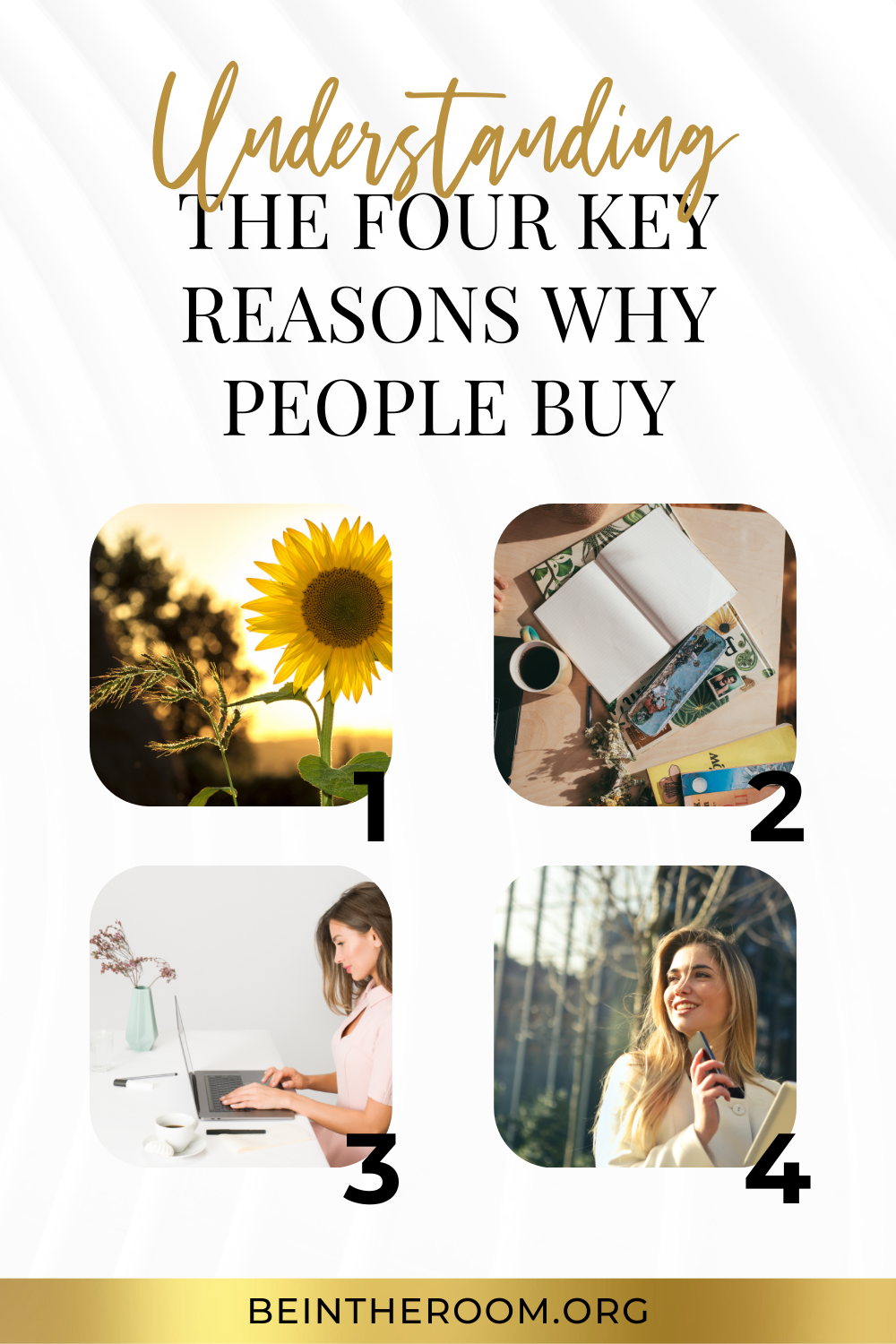The Conscious Leadership Blog
Hosted by Be in the Room: The Conscious Leadership Collective for Women in Business

Understanding The Four Key Reasons Why People Buy
Have you ever wondered how some people are able to charge high-ticket for their products and services while others are struggling to sell low-ticket offers identical to their high-ticket competitors?
It comes down to not what you sell... but rather how you sell. There will always be clients simply looking to get the cheapest price. There’s no avoiding that.
Business owners looking to charge high-ticket will need to accept those are not their people. Because those who charge high-ticket—and are constantly booked—have mastered the art of sales by appealing to the four key reasons people make buying decisions.

1. To Solve A Problem
Every buying decision consumers make solves a problem. That problem can be as complex as helping businesses boost their revenue through building excellent sales organizations or as simple as providing entertainment through video streaming services.
Your product or service, regardless of what it is, solves a problem. The more specific you can get with that problem, the more likely you are to attract clients seeking solutions. Think of all the problems your product or service solves—and remember to not solely focus on obvious solutions.
If you’re selling social media management, you’re selling the obvious, tactical solution of brand presence. But you’re also selling time. You’re giving back time to the busy business owner—time they can spend with their family and friends or use to focus on other areas of their business.
Messaging Example: "Build brand awareness, find new clients and engage with your audience all while gaining back hundreds of hours of your time."
2. Because They Feel Seen, Heard And Understood
Once you’ve identified the problems you solve, it’s important to present your solutions based on the specific needs of your potential client.
As humans, we need to feel seen, heard and understood. When you make your potential client feel this way, they’re more likely to buy from you. In any sales conversation, you should only be talking 20% of the time—the other 80% you are listening.
Listen to the needs of your ideal client. If they’re struggling with balancing time between their business and family, preset the solution of the time you can give back to them. However, if they’re talking to you about annual revenue goals, you’ll have better luck presenting them with solutions that focus on ROI.
It’s important to get inside the mind of your ideal clients. Acknowledge the things your typical client has tried in the past and assure them your solution is different.
Messaging Example: "You’ve tried X, Y and Z—and none of it worked. Because of that, you find yourself feeling defeated and stuck. But it’s not your fault. Those solutions were designed to X. You don’t need X. You need [enter your unique solution]."
3. Logical Reasons
People justify buying decisions with logic. There are tons of logical reasons people buy.
People invest in a wellness coach to improve their health. People invest in social media management to save time. People invest in high-end clothing for specific events like job interviews or date nights.
Perhaps the most popular logical reason is people are more likely “buy now” when products/services are on sale because they’ll save money.
Messaging Example: "Lose 20 lbs in six months guaranteed—40% Off! Limited time only." (I'll expand on this example in the next section).
4. Emotional Reasons
People justify with logic, but they buy based on emotion. Before you go listing all the logical reasons to invest in your product or service, you must appeal to the emotional reasons why someone should buy from you.
Logical: People invest in a wellness coach to improve their health.
Emotional: People invest in a wellness coach to run around with their children without getting worn out.
Logical: People invest in social media management to save time.
Emotional: People invest in social media management to give back time to their families. To be able to attend their kids' soccer games. To be able to spend more time with their spouse. To enjoy more family vacations without having to drag work along with them.
Logical: People invest in high-end clothing for specific events like job interviews or date nights.
Emotional: People invest in high-end fashion to feel sexy and confident on a date night with their spouse—to feel young again and rekindle an old flame. If it’s a first date, to make a great first impression on the one who may be their forever date.
Messaging Example (combining both emotion and logic): "Don’t sit on the sidelines this summer as your kids are splashing at the pool. Drop the weight, join the fun—and feel sexy doing it! Lose 20 lbs guaranteed—Summer Kickoff Special: 40% Off! Limited time only."
Understanding the four key reasons people buy is crucial for turning your low-ticket offers into high-ticket premium services. When you appeal to emotion, justify with logic, solve specific problems and make your audience feel seen heard and understood, you’ll still sign clients consistently—no matter what you’re charging.


